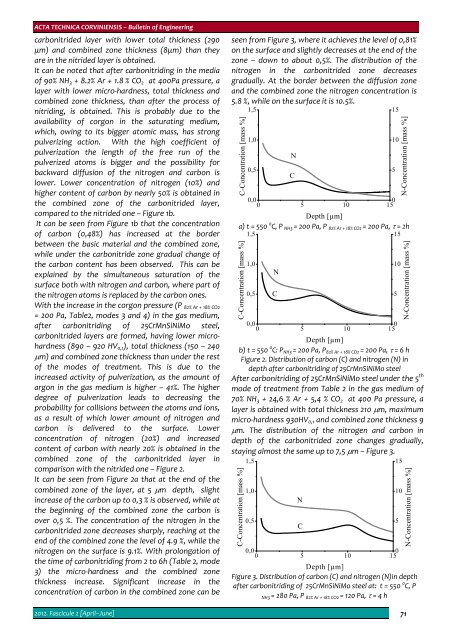Editorial & Advisory Board - Acta Technica Corviniensis
Editorial & Advisory Board - Acta Technica Corviniensis
Editorial & Advisory Board - Acta Technica Corviniensis
You also want an ePaper? Increase the reach of your titles
YUMPU automatically turns print PDFs into web optimized ePapers that Google loves.
ACTA TECHNICA CORVINIENSIS – Bulletin of Engineering<br />
carbonitrided layer with lower total thickness (290<br />
μm) and combined zone thickness (8μm) than they<br />
are in the nitrided layer is obtained.<br />
It can be noted that after carbonitriding in the media<br />
of 90% NH 3 + 8.2% Ar + 1.8 % CO 2 at 400Ра pressure, a<br />
layer with lower micro‐hardness, total thickness and<br />
combined zone thickness, than after the process of<br />
nitriding, is obtained. This is probably due to the<br />
availability of corgon in the saturating medium,<br />
which, owing to its bigger atomic mass, has strong<br />
pulverizing action. With the high coefficient of<br />
pulverization the length of the free run of the<br />
pulverized atoms is bigger and the possibility for<br />
backward diffusion of the nitrogen and carbon is<br />
lower. Lower concentration of nitrogen (10%) and<br />
higher content of carbon by nearly 50% is obtained in<br />
the combined zone of the carbonitrided layer,<br />
compared to the nitrided one – Figure 1b.<br />
It can be seen from Figure 1b that the concentration<br />
of carbon (0,48%) has increased at the border<br />
between the basic material and the combined zone,<br />
while under the carbonitride zone gradual change of<br />
the carbon content has been observed. This can be<br />
explained by the simultaneous saturation of the<br />
surface both with nitrogen and carbon, where part of<br />
the nitrogen atoms is replaced by the carbon ones.<br />
With the increase in the corgon pressure (P 82% Ar + 18% CO2<br />
= 200 Pa, Table2, modes 3 and 4) in the gas medium,<br />
after carbonitriding of 25CrMnSiNiMo steel,<br />
carbonitrided layers are formed, having lower microhardness<br />
(890 – 920 HV 0,1 ), total thickness (150 – 240<br />
μm) and combined zone thickness than under the rest<br />
of the modes of treatment. This is due to the<br />
increased activity of pulverization, as the amount of<br />
argon in the gas medium is higher – 41%. The higher<br />
degree of pulverization leads to decreasing the<br />
probability for collisions between the atoms and ions,<br />
as a result of which lower amount of nitrogen and<br />
carbon is delivered to the surface. Lower<br />
concentration of nitrogen (20%) and increased<br />
content of carbon with nearly 20% is obtained in the<br />
combined zone of the carbonitrided layer in<br />
comparison with the nitrided one – Figure 2.<br />
It can be seen from Figure 2a that at the end of the<br />
combined zone of the layer, at 5 μm depth, slight<br />
increase of the carbon up to 0,3 % is observed, while at<br />
the beginning of the combined zone the carbon is<br />
over 0,5 %. The concentration of the nitrogen in the<br />
carbonitrided zone decreases sharply, reaching at the<br />
end of the combined zone the level of 4.9 %, while the<br />
nitrogen on the surface is 9.1%. With prolongation of<br />
the time of carbonitriding from 2 to 6h (Table 2, mode<br />
3) the micro‐hardness and the combined zone<br />
thickness increase. Significant increase in the<br />
concentration of carbon in the combined zone can be<br />
seen from Figure 3, where it achieves the level of 0,81%<br />
on the surface and slightly decreases at the end of the<br />
zone – down to about 0,5%. The distribution of the<br />
nitrogen in the carbonitrided zone decreases<br />
gradually. At the border between the diffusion zone<br />
and the combined zone the nitrogen concentration is<br />
5.8 %, while on the surface it is 10.5%.<br />
C-Concentration [mass %]<br />
1,5<br />
1,0<br />
0,5<br />
N<br />
C<br />
0,0<br />
0<br />
0 5 10 15<br />
Depth [µm]<br />
а) t = 550 0 C, P NH3 = 200 Pa, P 82% Ar + 18% CO2 = 200 Pa, τ = 2h<br />
1,5<br />
15<br />
C-Concentration [mass %]<br />
1,0<br />
0,5<br />
N<br />
C<br />
0,0<br />
0<br />
0 5 10 15<br />
15<br />
10<br />
5<br />
N-Concentration [mass %]<br />
Depth [µm]<br />
b) t = 550 0 C: P NH3 = 200 Pa, P 82% Ar + 18% CO2 = 200 Pa, τ = 6 h<br />
Figure 2. Distribution of carbon (С) and nitrogen (N) in<br />
depth after carbonitriding of 25CrMnSiNiMo steel<br />
After carbonitriding of 25CrMnSiNiMo steel under the 5 th<br />
mode of treatment from Table 2 in the gas medium of<br />
70% NH 3 + 24,6 % Ar + 5,4 % CO 2 at 400 Ра pressure, a<br />
layer is obtained with total thickness 210 μm, maximum<br />
micro‐hardness 930HV 0,1 and combined zone thickness 9<br />
μm. The distribution of the nitrogen and carbon in<br />
depth of the carbonitrided zone changes gradually,<br />
staying almost the same up to 7,5 μm – Figure 3.<br />
1,5<br />
15<br />
C-Concentration [mass %]<br />
1,0<br />
0,5<br />
N<br />
C<br />
0,0<br />
0<br />
0 5 10 15<br />
10<br />
5<br />
N-Concentration [mass %]<br />
Depth [µm]<br />
Figure 3. Distribution of carbon (С) and nitrogen (N)in depth<br />
after carbonitriding of 25CrMnSiNiMo steel at: t = 550 0 C, P<br />
NH3 = 280 Pa, P 82% Ar + 18% CO2 = 120 Pa, τ = 4 h<br />
10<br />
5<br />
N-Concentration [mass %]<br />
2012. Fascicule 2 [April–June] 71

















